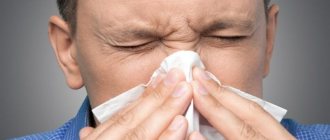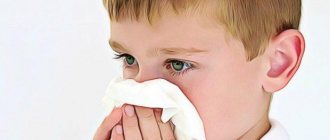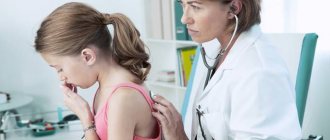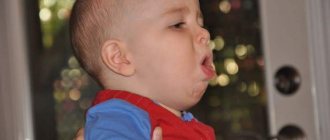Runny nose and sneezing are one of the main symptoms of colds.
In most cases, they are accompanied by fever and general malaise , but an increase in body temperature is not always observed.
This is not a reason to assume that the disease is mild. On the contrary, the absence of fever may indicate more serious pathologies than a simple runny nose and running snot .
Causes
Frequent sneezing and nasal congestion can appear due to external factors or arise due to dysfunction in the body or immune system.
Internal causes of such symptoms may be:
- allergic reaction - here, in addition to the signs described above, there is redness of the eyes, itching, swelling of the face;
- cold – a person has general malaise, weakness, cough, elevated body temperature;
- vasomotor rhinitis - occurs due to changes in vascular tone; characterized by increased mucus productivity; Symptoms intensify at night, i.e. in a lying position;
- chronic runny nose - untreated pathology or improper therapy leads to a chronic process; in this case, congestion and sneezing are expressed in the morning, since a significant amount of mucus collects in the nose.
The environment leads to external factors. Basically, after their elimination, the problem is eliminated by itself, and the person’s well-being is restored.
External reasons are as follows:
- dry air in the room - the nasal mucosa dries out, and rhinitis and sneezing become a protective reaction that helps to establish the microflora of the nasopharynx;
- hypothermia – these symptoms are complemented by a sore throat;
- spicy food, strong odors;
- smoking;
- failure to comply with hygiene measures;
- contact with an allergen (plant pollen, food, animal fur, etc.).
A runny nose and sneezing can be caused by unfavorable environmental conditions, prolonged use of certain medications, or bright sunlight.
If symptoms disappear spontaneously, there is no need to treat them. But when more than 3 days are observed, and the person’s condition noticeably worsens, it is necessary to consult a doctor.
Sneezing and runny nose without fever in a child
This condition in children is caused by the same reasons as in adults - poorly organized climate in the room (apartment, kindergarten group), acute respiratory infections, allergies.
Psychological reasons can also be added here. This often happens to boys. From an early age we tell them “Don’t cry, you’re a boy!”, and stuff like that. And when the child goes to kindergarten, a whirlwind of snot begins. Parents run from doctor to doctor, at the same time they are treated for acute respiratory infections, acute respiratory viral infections and all the diagnoses that are made, tests for allergens are taken. But here it’s worth stopping and figuring out whether the child may be uncomfortable in the garden - there may be different reasons for this, and each case has its own solution:
- children push and bite - you need to teach your child to defend his boundaries;
- discomfort from a public toilet (perhaps the child can only use his own potty) - buy and take to the garden the same one he uses at home, etc.
The nose is connected to the eyes and the lacrimal gland, among other things. Excess tears also come out through the nose (few people manage to cry without snot). And if the baby is forbidden to cry, but there is a need for tears, then the child begins to cry through his nose. Hence the stuffiness and runny nose.
Try to identify and eliminate problem areas in the little person’s social life, and perhaps there will be fewer snooping periods. How to do it? You can simply ask the child, or you can transfer everything into the game - let the dolls and toys go to the “kindergarten”, and observe what dialogues and situations the child builds.
When to go to the doctor
Not all people pay attention to a runny nose or sneezing. When symptoms persist for more than 2 days, they begin to use various medications. However, this is wrong. If you have the following symptoms, you should consult a doctor:
- body aches;
- swelling of the nasal mucosa;
- nausea, vomiting;
- fever, chills;
- rapid or, on the contrary, weak pulse;
- lacrimation;
- dyspnea;
- malaise, weakness, dizziness.
The person also develops a headache and cough. All these signs indicate an advanced cold, flu or other dangerous infection.
Runny nose and sneezing without fever in an adult: how to treat?
First of all, you need to identify the cause of this condition and only then begin treatment.
Here you need to remember that there are 5-7 days during which you can independently treat a runny nose at home. Both medicines and traditional medicine methods can be used. If you tackle the situation wisely, everything will pass. If nothing helps, and after a week, handkerchiefs are your constant companions, then this is a reason to consult a doctor. And together with him, look for solutions.
It is important to build the correct algorithm of actions:
- constant hydration of the mucous membrane;
- remove all possible allergens and irritants;
- Use nasal drops and sprays only in exceptional cases when you cannot do without them.
Only after these three points can you add folk methods in the form of infusions, mustard plasters, warming up your feet, etc.
Why does a person sneeze when he has a cold?
If a person sneezes - is it good or bad, many people ask this question. Frequent sneezing during a cold is a protective reaction of the body. So he tries to eliminate mucus, speed up the removal of the inflammatory process that has accumulated in the nasal cavity. Under no circumstances should you hold back your sneezing, this will create a barrier against infection. Often, this symptom at the initial stage of the pathology interrupts the subsequent development of the disease.
Sneezing is considered an innate reflex that allows you to eliminate from the respiratory tract various irritants that excite the nasal mucosa.
Sneezing and runny nose without fever during pregnancy
Gestation of a child lasts 9 months, that is, three seasons. And no matter what period your pregnancy occurs, seasonal outbreaks of acute respiratory diseases cannot be avoided. Therefore, the first thing when planning a pregnancy is to think about getting a flu shot. It is this disease that poses the greatest danger to mother and child.
And only by getting vaccinated, when rhinitis and sneezing appear, you can be sure that it is not the flu, but a common acute respiratory infection.
Pregnancy makes a woman more vulnerable to infections, since immunity is reduced (this is a natural phenomenon that ensures pregnancy).
During pregnancy, you should not resort to self-medication. Even a minor cold is best discussed with your doctor. Only he can prescribe medications that are safe for your situation.
Nasal congestion can also occur due to hormonal surges. In this case, only this symptom is observed. If such a condition interferes with the quality of life, the specialist will prescribe medications that will act symptomatically.
How to fix the problem
When a person has sneezing and a runny nose without fever, therapy should be carried out after the cause has been established. If you sneeze once or the symptom lasts throughout the day, you should not rush. Maybe the reason for this is dry air. To solve the problem, just ventilate the room and use a humidifier. Then the nasal mucosa will not dry out and provoke sneezing. You can buy a humidifier at the store; if you don’t have one, just hang wet towels around the room.
If the patient is sneezing and snot is flowing, you need to pay attention to other signs: cough, increase in body temperature. To avoid worsening the disease, you need to seek help from a specialist.
Drug treatment
Inhalation and nasal rinsing will help alleviate the condition. Medications include moisturizing and vasoconstrictor medications. When a runny nose, sneezing, and a temperature of 37.2°C or higher become signs of a viral pathology, nasal antiviral agents will be effective in treatment .
In the case of allergic rhinitis - antihistamines. Your doctor may prescribe the following medications:
- Vasoconstrictors (Sanorin, Nazivin, Tizin, etc.) - relieve swelling of the mucous membrane, restore breathing. The products are used for no more than 7 days to prevent addiction. Contraindications include pregnancy and chronic atrophic rhinitis.
- Moisturizing (Aquamaris, Aqualor) - consist of sea water, mainly used as an addition to the main treatment. Nutrients activate the functioning of the glands of the respiratory organs.
- Antiviral (Interferon, Grippferon) - are more used for preventive purposes or at the first stage of development of the disease that was provoked by the virus. They help prevent the spread of infection. Used to stop sneezing during acute rhinitis.
- Antibacterial (Isofra, Bioparox) - can be purchased in the form of aerosols, are suitable for treating the upper respiratory tract, treating internal infections that cause sneezing and runny nose, and exhibit an antibacterial result. Medicines act on a specific area, therefore they are allowed for small children and pregnant women.
- Homeopathic (Larinol, Tonsilgon) - created from essential oils, have an antiseptic, refreshing effect. They help eliminate swelling and also produce an antiviral effect on the human body as a whole.
It is worth noting that drug treatment will have a positive effect on the nasal mucosa and respiratory organs if personal hygiene procedures are performed, constant ventilation, wet cleaning and air humidification.
Nasal rinsing
To stop sneezing and severe runny nose, you should rinse your nose. This method can remove any irritating substances from the cavity, the presence of mucus, eliminate swelling and normalize breathing. In addition, rinsing becomes a good preventative measure for colds.
To make the manipulation most effective, use the following solutions:
- herbal infusions;
- filtered purified water or boiled;
- sea salt, saline solution;
- vegetable juice (if there is no allergic reaction);
- a weak solution of Furacilin, Iodine, Manganese.
Rinsing is carried out using a special syringe, morning and evening. ARVI or a suspected cold can be cured with the help of a decoction of calendula and chamomile. When the nose is stuffy and the temperature is elevated, taking antiviral medications is indicated.
Treatment of allergic sneezing
When sneezing in adults is of an allergic nature, the doctor prescribes tablets, ointments, aerosols, and other antihistamines.
They completely destroy the infectious agent. While the remedy is in effect, the body loses any sensitivity to the pathogen. The vessels contract, swelling disappears and negative manifestations no longer torment. In order for medications to help get rid of a runny nose faster, you should follow simple rules when sneezing:
- after going outside, you need to take a shower, change things so that there are no irritating agents on the skin;
- stop smoking;
- be sure to buy a humidifier so that the mucous membrane does not dry out;
- Carry out wet cleaning daily; there should be no dust or animal hair in the room;
- It is not recommended to dry things outside when plants are blooming intensively.
By following these simple recommendations, you can speed up the healing process.
Traditional methods
If a person suffers from lacrimation, sneezing, liquid mucus flows from the nose and there is no opportunity to visit a doctor, they resort to folk recipes. Inhalations are very effective for a runny nose.
Also common means are:
- massaging movements of the maxillary sinuses;
- rinsing the nasal cavity with chamomile infusion;
- aromatherapy using lemon, eucalyptus and other oils is effective;
- If you have a cold, be sure to drink plenty of fluids and stick to bed rest;
- The nose can be instilled with beetroot, carrot juice and Kalanchoe, diluted in water.
Before using traditional recipes, you need to make sure that there is no allergic reaction to them.
Why can a runny nose and sneezing occur without fever?
You will be surprised, but many do not even notice that they have a runny nose. It manifests itself in the form of congestion, and there is no snot as such.
A shortness of breath test can be done to determine if there is congestion.
To test, you need to close one nostril with your finger, bring the cotton wool to the second nostril at a distance of 3 cm and breathe. Do the same with the second nostril.
Our sense organ constantly produces a secretion that washes away germs and everything unnecessary that enters the nose along with the air. When a person gets sick, the nose begins to work actively, producing more secretion than usual, and then the nasal flow begins. Sometimes it flows, and sometimes it just clogs up - both phenomena will be called rhinitis.
Normally, 90% of inhaled air passes through the nose, which is where it:
- filtered (all fine suspended matter (dust, microbes) is removed);
- moisturized;
- warms up.
Another thing is that it is sometimes impossible to live with this protection. And this is not only when the nose is running so bad that there are not enough supplies of napkins, this can also include nasal congestion.
Why does my nose get stuffy? The reason is swelling of the nasal mucosa. And if liquid accumulates in the tissues of the mucous membrane, it increases in size, closing the passage to the nose. Swelling prevents you from breathing fully.
Swollen mucous membranes may be the result of occupational hazards, for example, among flight attendants. On an airplane there is an atmosphere of a dry climate plus pressure changes - all this is reflected in the nasopharynx. Therefore, you need to constantly moisturize your nose.
A runny nose, sneezing, and congestion can occur for various reasons, and the most common are:
- microparticles and dust, chemical . substances that cause irritation to the mucous membranes
This problem often arises among miners; unfortunately, there is no way to hide from coal dust. The situation is similar in a regular computer workshop. When replacing a cartridge in printers, toner (fine ink powder) can scatter throughout the room. It goes not only to the person who makes the replacement, but to all employees. Therefore, a business owner should take care of a separate room (or at least a closed cabin) for this type of work, and, of course, personal protective equipment - a respirator - should not be forgotten.
Even if you are a housewife and are far from coal dust, and dust in general, and the congestion does not leave you alone, then you should carefully look around the house. This condition can also be caused by an excessive craving for cleanliness, which is achieved with all kinds of chemicals. To solve the problem, it will be enough to simply switch to another environmentally friendly product;
- viral or cold infection (ARI) . The first thing you think about if you have sneezing and a runny nose. But here the general condition worsens further with aches, weakness, drowsiness, and sore throat. Depending on the immune system and the infection encountered, the intensity of symptoms may vary.
Is it bad if colds are accompanied by sneezing and runny nose without fever? After all, temperature helps fight viral infection. Indeed, the virus usually stops reproducing at temperatures of 38°C and above. Therefore, there is no need to lower your temperature if it exists and does not interfere with your life. Here we can say that you were lucky and you caught the wrong virus. If it were a serious virus (for example, the flu), then the temperature would rise - there is no escape from this (if there are no problems with immunodeficiency, then serious viral infections do not go away without fever). In fact, we are talking about a common respiratory virus that causes acute respiratory infections. There are a lot of them, hundreds of these viruses. ARI differs from more aggressive viral diseases in that the temperature is either insignificant or absent at all, but only sneezing and coughing.
Forecast
A runny nose and sneezing are quite common symptoms that many simply no longer pay much attention to them, and the problem remains unresolved. Inaction can lead to the pathology becoming chronic or provoke dangerous inflammation. You can overcome annoying sneezing both through medications and traditional methods. And do not forget that the most seemingly harmless sign can be the initial signal, so there is no need to leave the disease to chance.
It is very important to maintain immunity, take vitamin complexes, exercise, and use immunomodulators . Restore your diet; certain foods can cause allergies and other disorders in the body.
Treatment with medications
Before using medications, you should consult with your doctor, who, based on your symptoms, will prescribe the right medicine and its dosage.
Drugs that constrict blood vessels
Most often in such cases, doctors recommend vasoconstrictor drugs to their patients. Such drugs can be drops or sprays that provide symptomatic treatment. The main goal of symptomatic treatment is to reduce swelling, as well as hypersecretion of the nasal mucosa. The active ingredients of the drugs reduce the lumen of blood vessels at the site of their administration.
It should be remembered that vasoconstrictor drugs can only provide a temporary effect that makes breathing easier. In most cases, the problem returns again. The duration of the achieved effect directly depends on the composition of the product and can reach 12 hours. Experienced experts recommend taking such drugs for no more than 5 days. Otherwise, their further use may provoke addiction. When using vasoconstrictors, doctors recommend using different medications with different compositions. In this way, it is possible to reduce the risk of addiction and identify a more effective remedy. Having gotten rid of the disease, you should not continue to take medications for preventive purposes.
Nasal rinses
If the cause of the problem is rhinitis, then certain procedures using medications will be required. In particular, we are talking about rinsing the nasal cavity with saline solutions. Thanks to such actions, it is possible to cleanse the mucous membrane of foreign small particles that the body is not able to cope with using normal protective reactions.
With the help of procedures, the severity of inflammation is reduced and regeneration processes are activated. The drug should be used before using drops or other medications. In this way, it is possible to achieve the best effect of treatment.
Antibacterial agents
You can stop sneezing in adults using antibacterial agents. The feasibility of treatment using antibacterial drugs is revealed only after analyzing the results of bacterial culture. It is this type of analysis that makes it possible to determine the presence of infection and bacterial pathogens.
Use of immunomodulators
The use of immunomodulators can also give good results. There are drugs whose action is aimed at increasing the protection of the respiratory tract mucosa from the penetration of infectious bacteria into them. But the result of the treatment will become noticeable only after a few weeks.
In some cases, a runny nose and sneezing occur as a result of the influence of an allergen. Allergies require special treatment, which consists of the following:
- oral antihistamines;
- local use of antiallergic drugs;
- preventing contact with a possible allergen.
If the treatment does not produce results, the doctor will prescribe hormonal medications that will need to be taken.








